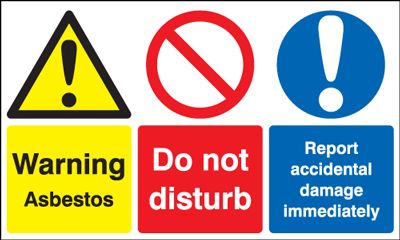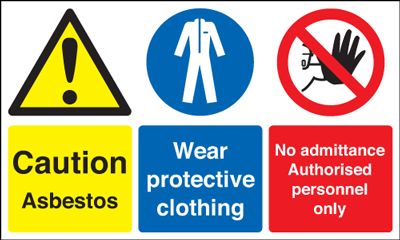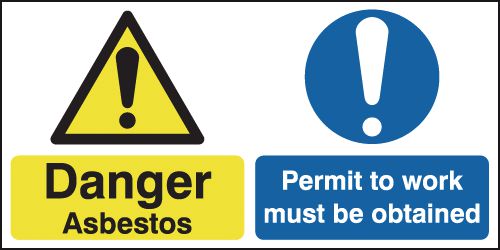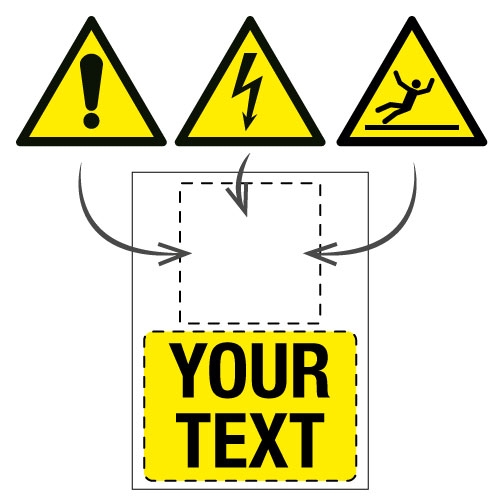-
Promotion

Danger Asbestos Signs
From £2.99 To £31.99
From £2.52 To £24.90
Supplied in: Single -
Promotion

Warning Contains Asbestos Signs
From £2.02 To £11.99
From £2.02 To £8.40
Supplied in: Single -
Promotion

Warning Asbestos/Do Not Disturb... Multi-Message Signs
From £3.99 To £33.20
From £3.59 To £29.25
Supplied in: Single -
Promotion

Caution Asbestos/Protective Clothing Signs
From £20.99 To £43.99
From £17.99 To £38.03
Supplied in: Single -
Promotion

Caution May Contain Asbestos Signs
From £2.02 To £11.99
From £2.02 To £8.40
Supplied in: Single -
Promotion

Danger Asbestos Permit To Work Must Be Obtained Signs
From £20.99 To £43.99
From £18.35 To £38.03
Supplied in: Single -
Promotion

Warning Asbestos Signs
From £5.99 To £31.99
From £4.62 To £25.36
Supplied in: Single -
Promotion

Asbestos/Wear Protective Clothing Stanchion Sign
£80.99
£68.85
Supplied in: Single -
 Customisable
Customisable

Custom Safety Signs
-
 Customisable
Customisable

Custom Hazard Signs
-
Promotion

Caution Asbestos Signs
From £3.99 To £50.99
From £3.87 To £34.38
Supplied in: Single -
Promotion

Danger You Are Entering An Asbestos Area Signs
From £16.99 To £31.99
From £14.39 To £27.45
Supplied in: Single -
Promotion

Asbestos/Do Not Disturb/Avoid Damage Signs
From £3.99 To £43.99
From £3.59 To £38.03
Supplied in: Single -
Promotion

Danger Asbestos Signs with Health & Safety Guidance
From £28.99 To £46.99
From £22.64 To £29.72
Supplied in: Single -
Promotion

Danger Asbestos Guidance Safety Signs
From £21.99 To £29.99
From £16.67 To £25.84
Supplied in: Single -
Promotion

You Are Entering Asbestos Area Point of Entry Floor Sign
£20.99
£10.08
Supplied in: Single -
Promotion

Caution Asbestos Health & Safety Guidance Signs
From £28.99 To £46.99
From £22.64 To £29.72
Supplied in: Single
Asbestos Warning Signs
Need help?
 Your legal requirements regarding asbestos explained
Get the right Asbestos Warning Signs & Avoid Huge Fines!
Your legal requirements regarding asbestos explained
Get the right Asbestos Warning Signs & Avoid Huge Fines!
Asbestos can be a danger to any workplace. Inhaling asbestos fibres can lead to serious illness and even death. It’s therefore crucial to identify any potential asbestos hazards within your premises so that people can be warned and informed of its dangers. Asbestos Warning Signs should be affixed anywhere there is a risk of asbestos in order to ensure that your workplace complies with the Control of Asbestos Regulations 2012 legislation.
Our signs are available in various materials and in a range of different warnings and sizes. Suitable to display both indoors and outside our Asbestos Signs help to ensure the safety of those on site.

Expert Information
Also discover:
Safety signsElectrical SignsHarmful Substances SignsFlammable signsTrip hazard signCaution SignsChemical signsWarning signsPedestrian warning signsTemperature Warning SignsHazardous Area SignsCctv signsForklift Warning Signs
Summary of Asbestos
Asbestos refers to a group of harmful minerals that are made up of fine, durable fibres and are resistant to heat and many chemicals. Asbestos was once commonly used as a building material, often during jobs such as insulating buildings and laying floor tiles.
Although it’s now illegal for construction workers to use asbestos when constructing or refurbishing buildings, there are many places where it has been used historically and remains to this day.
Though it poses no real threat to passers-by while undisturbed, once these materials are disturbed or removed, asbestos particles can enter the air and become extremely dangerous.
Is Asbestos Dangerous?
Yes, asbestos is dangerous. Touching it can cause calluses to form on the skin, and inhaling it can lead to serious health issues, most of which are life threatening. In fact, accidentally ingesting it can increase the risk of developing different kinds of cancers. Asbestos is a serious environmental hazard, due to which its global use has declined significantly in the past decade or so.
Dangers of Asbestos
Asbestos kills – an unbelievable number of people die each year in the UK alone from this silent killer. For this reason, it is imperative that any potential asbestos hazards are identified, so that no further fatalities are caused.
Breathing air contaminated with asbestos dust and fibres can cause you to develop several serious asbestos-related illnesses including lung cancer, mesothelioma, asbestosis and pleural plaques – which commonly lead to death.
Why is Asbestos Dangerous?
Although all forms of asbestos are considered hazardous, different types of asbestos fibres may be associated with different health risks. Some of the most common illnesses caused by exposure to asbestos include.
Mesothelioma: The lining covering the lower digestive system (peritoneum) and the lining of the lungs (pleura) are both affected by the malignant mesothelioma. When it is identified, it is nearly invariably lethal and is almost solely linked to asbestos exposure.
Thickening of the pleura: Generally, pleural thickening is an issue that arises with extensive asbestos exposure. The pleura, or lung lining, expands and thickens, and should the condition worsen, the lung may be compressed, resulting in dyspnea and thoracic pain.
Asbestosis: Asbestosis is a dangerous lung ailment that usually develops after years of prolonged, high asbestos exposure. This illness may result in increasing dyspnea and, in extreme situations, may be lethal.
Despite its deadly nature, asbestos only poses a threat to your health when it is disturbed and its deadly mineral fibres are released into the atmosphere around you. This means that, provided the correct health and safety procedures are in place and that the guidelines set in the Control of Asbestos 2012 legislation are adhered to, its risk to your health can be massively reduced.
All visitors to your workplace should be warned of any potential asbestos risks through clear, visible signage that complies with regulatory standards. Displaying Asbestos Warning Signs is an activity that every workplace should take some time to consider, and isn’t something that should be taken lightly.
On asbestos safety signs and labels, vivid background colours such as yellow, green, red, and blue are typically used to draw attention right away, as it is difficult to ignore and can be easily spotted in most environments. In the same vein, the language and image combination of the sign is intended to be comprehensible to all viewers. Should the individual be able to read the sign, they ought to deduce the possible hazard from the wording; if not, their only means of comprehension will be the pictograms on the labels
Ensure your premises complies with legislation by fitting asbestos warning signs, but don't forget some of our range may require specific sign fixings to secure them in place.
Asbestos and the Law
To help workplaces meet the required standard, guidelines were set out in the Control of Asbestos Regulations 2012 legislation. These specifically refer to non-domestic buildings, such as commercial, industrial or public premises (including schools, warehouses, offices, hospitals, shops and factories).
These regulations cover the identification of asbestos exposure, asbestos testing and inspection, guidance on performing a thorough asbestos risk assessment and professional asbestos removal (which should only ever be carried out by specifically licenced contractors).
Occupational Safety and Health Administration (OSHA) states that employers, landlords and building owners must post signs to identify asbestos-containing and potentially asbestos-containing materials. This includes signage to show exactly where these materials are as well as other literature to show how to avoid disturbing it.
These signs must be posted at the entrance of all areas that may or may not contain asbestos. Anyone working within these zones must be made aware of its presence and take all necessary steps to safeguard their health, such as wearing Protective Clothing and Respiratory Protection masks.
Importance of Asbestos Signage in the UK
As highlighted, the use of asbestos for any new building projects has been banned in the UK. However, the British Government has taken a strict initiative to make it compulsory for people to mark all buildings, structures, and objects that have been previously made using asbestos. The Control of Asbestos Regulations 2012 are the most recent rules that are in effect.
Asbestos management is required for non-domestic properties (Regulation 4). This guarantees that asbestos is kept in a safe manner and that workers and employees are informed of its existence.
You must take precautions to keep yourself and others safe from asbestos exposure at work, even if you work for yourself or hire people. This also applies to residential property. Regulations 5 and 6 address this.
In case your company fixes or maintains outdated machinery, equipment, cars, ships, military hardware, etc., make sure that no asbestos-containing interior parts need to be replaced.
At Seton, we have a great collection of asbestos warning signs that can help you to keep your premises a safe and healthy place for everyone around you. Some of the most appropriate asbestos warning signage for your building and workplaces could include warning asbestos sign, danger asbestos signs, danger asbestos keep out sign, caution asbestos sign, and caution asbestos health & safety guidance signs.
More Information
If you’re struggling to find the Warning Signs best suited to your needs, or require more information before making a decision, contact a friendly member of our team who will be able to assist you further.
For more hazard warning signs, check out our full range for other hazards in the workplace.




